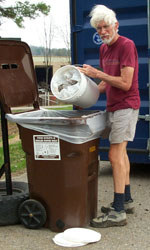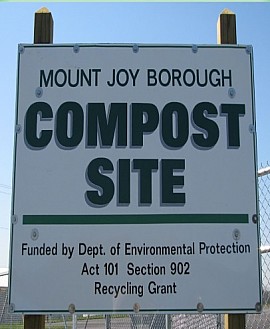February 25, 2014
Options for residential organics collection include: drop-off (transfer stations, recycling centers, or “convenience centers”); door-to-door service (“curbside”); and “modified” curbside or neighborhood collections. These alternatives may be used as stand-alone options or in combination with one another. A mulch or compost operation, whether municipal, farm-based, or commercially operated, will need to be in place prior to establishing a residential organics collection system.
Drop-off systems are the primary method for waste management in rural areas and small towns. Organics can easily be managed at drop-off sites and works effectively in areas where residents already deliver their household discards to landfills or transfer stations. Drop-off systems generally result in lower community participation when compared with curbside collection systems. However, if properly incentivized and promoted, rural and small towns can achieve strong diversion rates from drop-off organics programs.
 Organics collection containers can be placed at transfer stations, public works yards, or other location(s) in a community for residents to unload their organic materials. A container system is typical if materials are to be stored and transferred to an offsite organics processing site. Container and transportation technologies can impact the overall costs of drop-off compost collection/transfer systems.
Organics collection containers can be placed at transfer stations, public works yards, or other location(s) in a community for residents to unload their organic materials. A container system is typical if materials are to be stored and transferred to an offsite organics processing site. Container and transportation technologies can impact the overall costs of drop-off compost collection/transfer systems.
Some systems rely on private contractors to provide rental containers (e.g., 30 - 40 cubic yard roll-off dumpsters) and transportation of materials to a processing site. Others employ homemade containers, existing trucks, and municipal employees to collect and transport materials. Food scraps can be collected with yard debris or separately in smaller dumpsters or carts. If a container system is used, the containers must be monitored and emptied regularly to prevent odors.
Alternatively, residents can drop-off “loose” materials at a designated location for grinding, mulching, or composting onsite. If materials are to be managed onsite, the drop-off location should be next to or near the processing area in order to minimize the amount of material handling. The area needs to be safe for residents to access and conveniently leave materials. Food scraps can be collected in a container and later mixed in with other organics at the site for composting.
Mobile or temporary yard debris drop-off sites can also be established during seasonal periods, such as for leaves in the fall and brush in the spring. Mobile sites can allow communities to provide collection where space is limited and/or as a supplementary service during seasonal peaks in organics material generation. Temporary containers can be set on a site once a week or once a month for collection of wood waste, yard debris and/or other materials. At the end of the day or designated period, the container would be hauled to a processing facility. Appropriate sites could include transfer stations, recycling centers, retail centers, or other convenient, public locations.
Permanent drop-off programs tend to capture more material than a mobile system because permanent sites are often more convenient (located where residents normally dispose of waste) than temporary or mobile ones. Additionally, the ongoing presence of a permanent collection location serves to remind residents of the opportunity to recycle their organics.
Permanent drop-off locations are generally more costly to operate than the mobile drop-off sites, as permanent sites require more maintenance and increased transportation costs since permanent sites are ongoing and more material is typically collected. However, residents are better served, more organics diversion occurs, and the cost per ton collected would be lower due to the larger volumes collected. Drop-off centers can typically accommodate school, institutional, and small commercial generators as well.
An issue with drop-off sites is the potential problem of contamination which can occur if trash or other materials are discarded with the organics (such as materials placed in plastic bags). Placement of the drop-off site at a staffed facility, such as a transfer station, helps to reduce the concern. In addition, staff can help to answer resident questions about acceptable materials.
Attendant training is necessary to ensure that attendants know what materials are acceptable and how materials can be contained—for example, if materials are acceptable in paper bags. Attendants will also need to know the acceptable dimensions of brush if this material is collected.
Opportunities
A drop-off program is an appropriate management system in rural and small town areas as costs are significantly lower than curbside collection. Drop-off systems can also be used as a means to pilot food scrap collection in more suburban and urban areas. Collection container options allow for a wide variety of transport possibilities to offsite commercial, farm, or regional composting facilities. Onsite mulching or composting at the point of collection (such as a town transfer station) can also be implemented. Food scraps can also easily be added to a drop-off program. Drop-off programs can also serve to supplement residential curbside collection of organics to allow multi-family residents, schools, and small business generators to participate.
 Regionally operated landfill facilities and similar operations may present drop-off siting opportunities for organics when municipal space or funding is limited. Exploring partnerships with a local garden center, landscaping company, farm, or other business for mulching or composting may present a viable drop-off collection option for residents and small businesses. The cooperating business can benefit by charging tipping fees and selling the resulting compost, as well as increased foot traffic.
Regionally operated landfill facilities and similar operations may present drop-off siting opportunities for organics when municipal space or funding is limited. Exploring partnerships with a local garden center, landscaping company, farm, or other business for mulching or composting may present a viable drop-off collection option for residents and small businesses. The cooperating business can benefit by charging tipping fees and selling the resulting compost, as well as increased foot traffic.
Educating residents is important in order to foster awareness about the benefits of composting and to help alleviate confusion over what is and what is not acceptable. Participants need to know if materials can be bagged and what type of bag can be used (e.g., paper vs. plastic); if there is a size limit on tree limbs; and if brush and limbs can be bundled with twine. Acceptable food scraps, soiled paper, and compostable service ware will also need to be described if these materials are included.
There may be concerns about drop-off programs; ranging from wildlife to odors. Keeping bears and other critters away from food scrap collection bins can be a concern. Unattended bins (such as at night) should remain locked and secure. When food is deposited in the bins it is important that it be completely covered by a thin layer of sawdust and even lime. A bucket or cart of sawdust can be kept next to the collection containers, with a sign asking residents to cover the food scraps with a layer of sawdust. Meat, dairy, and grease should not be collected if there is a concern. Odor issues should be addressed through regular and timely removal (or processing) of stored materials.
Next Up: Residential Drop-off Organics Collection—Action Tips and Who’s Doing It?
By Athena Lee Bradley


Comments (0)
Add a Comment